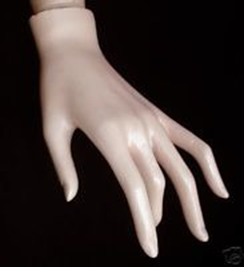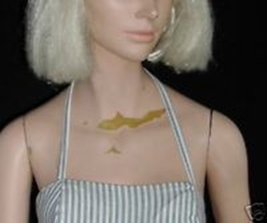How Do I Repair My Antique Wax Mannequin Head
How to Repair a Mannequin – Part 1 of a 2 function series

Since we sell new, used and vintage mannequins at Mannequin Madness we get lots of emails about mannequin repairs. Nosotros transport our repairs to professional mannequin refurbishing companies you tin can observe on the blog postal service we wrote here:
We highly recommend that use those companies if you take a mannequin that you lot feel is collector level or if your mannequin has extensive impairment.

But for your everyday mannequin with relatively minor repairs or painting you can probably exercise information technology yourself, if you are handy.
Nosotros've culled the net to notice the best data on this topic. This is the first in a three function series from a vendor we plant on Ebay, called lucitebox. who has written various mannequin repair guides.
This guide they call Painting Your Lady:
To pigment your mannequin, yous will need to first clean your manni'southward arms with rubbing alcohol and a cotton pad.
Don't rub too hard, only get the surface dust off and whatever dirt. (If you rub too difficult, you'll remove a lot of the erstwhile paint and most of the polish. You might desire to exam an inconspicuous surface area first.)
Have your clean mannequin arm in a tote pocketbook to Abode Depot (or any place that mixes custom paint colors.) It's probable that the folks at the paint counter will think you're weird and they might recall they cannot assistance you, but they can.

A scan of the forearm should yield a color close to what y'all want. You tin can as well try matching your arm with colors in the rack, but custom colors may work all-time.
I bought my pigment at Home Depot. They sold me a quart of interior satin enamel. It's Behr Premium Plus — Pastel Base no. 7500. I doubtable this is the paint used to mix custom colors. It does seem to be a perfect lucifer.
Get the finest quality 1-2″ size brush y'all can afford. Utilise smoothen coats of paint to the area. If you're doing a larger area (like the chest), get a very small fine roller, too.
The small roller is about 2 inches long. It's meant for edging, I believe. It's sort of sponge-similar. Moreover, if you know how to apply an airbrush, this might be the time to apply your skills.
If you don't accept one or don't know how to use one, then but utilize the castor and roller method. Another suggestion, though I oasis't tried information technology, would be to mix your paint with some Matte Medium which is what fine artists sometimes use to work with acrylic pigment.
This volition allow you to sparse the pigment just not dilute the color. Matte Medium will allow you to use many layers of pigment–slowly, simply evenly.
If you're doing something more detailed like hands, you lot might want to place them on a slice of white waxed freezer paper that'due south taped to your tabular array. (Note–exercise not use the brown butcher paper. Get white freezer paper with wax on one side.)
Or, you could paint the easily while they're on the arms attached to the manni. If you've got a skillful paint color match, you shouldn't have to paint the whole arm–just the hands.
Use equally little paint as possible rather than applying a lot of paint. A few coats rather than 1 thick coat looks best.
When I did this paint job, my castor was too quondam, dry out and thick.

I would have used a better brush had I known I'd terminate upwards with some streaky strokes.
(You can't really encounter them in the photos, simply in real life they're there.)

Delight be sure that you're always painting a clean area. If you've got cracks or chips in the surface area, you should sand them.
If there are major breaks, you will need to fix them. This footstep-past-pace Bondo method works well.
Below yous tin can meet some other area of my mannequin that was damaged. The glaze of original paint on the manni was very thick so it had to be sanded polish earlier painting.
Here's a before and after:


When painting the chest, I simply rolled over the surface area that was sanded and then composite areas with ane of those flat sponge "brushes" then I didn't have to practice the whole torso.
You can, of class, exercise the whole trunk, simply try to use as piffling paint as possible, always layering rather than heavily blanket any surface.
If you want, now that you have your perfectly matched color, you tin touch up any problem areas using very, very thin coats and a small sponge applicator. I dabbed some pigment on the scrap that'due south on her olfactory organ, but ideally, that surface area should exist sanded and repainted, likewise.
A frequently used mannequin that's shop worn and ravaged by time tin sometimes be a plough-off in auctions.
A damaged mannequin does trivial to enhance your garments and can actually detract from the article of clothing. Editing and re-touching photos in a photo editing program takes time.
In the long run, it may be better to repair and repaint your mannequin. Your auctions will look that much amend once you restore the youthful glow to your vintage manni.
Source: https://blog.mannequinmadness.com/2014/08/how-to-repair-a-mannequin-part-1-of-a-2-part-series/
Posted by: reeddrempan1965.blogspot.com


0 Response to "How Do I Repair My Antique Wax Mannequin Head"
Post a Comment